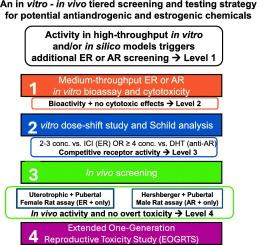用柴尔德回归分析体外确定雌激素和抗雄激素农药的生物活性
IF 3.4
3区 医学
Q2 PHARMACOLOGY & PHARMACY
引用次数: 0
摘要
据报道,使用高通量筛选(HTS)的体外分析,广泛的人为化学物质显示出雌激素(ER)或抗雄激素生物活性。一些监管机构已经开发出分级的体外-体内内分泌筛选电池,在这种电池中,阳性的体外结果会自动“触发”实验动物的研究。由于体外试验可能产生许多假阳性和假阴性结果,自动触发体内试验可能导致不必要地使用动物和其他资源。报道的AR拮抗剂的体外假阳性率可能特别高,因为许多非特异性机制可以破坏竞争性AR剂量反应测定,从而使化学物质错误地显示为竞争性AR配体。在目前的研究中,我们展示了利用体外Schild回归来询问在HTS ER或AR模型中呈阳性的农药的体外ER和/或抗AR生物活性。柴尔德回归区分作为真正竞争性受体配体的化学物质和那些通过非竞争性机制破坏信号的化学物质。所研究的化学物质包括7种被EPA列为体内ER或抗ar高优先级的农药和2种被列为低优先级的农药,以及17β-雌二醇(E2)和羟氟甲酰胺(OHF)作为ER和抗ar参比配体。检测内质网激动剂活性的四种农药中有两种具有细胞毒性,检测AR拮抗剂活性的七种农药中有四种,加上OHF,是真正的竞争性AR拮抗剂(两个真阳性和两个假阴性)。在此,我们提出了一个分层策略,包括使用Schild回归对体外生物活性进行更深入的分析,以确定HTS或其他体外生物活性数据是来自真正的竞争性受体拮抗还是一些非特异性机制。这种策略可以减少在体外对非AR拮抗剂的化学物质进行不必要的体内测试。本文章由计算机程序翻译,如有差异,请以英文原文为准。

In vitro confirmation of estrogenic and antiandrogenic pesticide bioactivity using schild regression analysis
A broad range of anthropogenic chemicals have been reported to display estrogenic (ER) or antiandrogenic bioactivity using high throughput screening (HTS) in vitro assays. Some regulatory agencies have developed tiered in vitro – in vivo endocrine screening batteries in which positive in vitro results automatically “trigger” studies with laboratory animals. Since in vitro assays can produce a number of false positive and false negative results, automatically triggering in vivo testing could result in the unnecessary use of animals and other resources. The in vitro false positive rate may be particularly high with reported AR antagonists, because many nonspecific mechanisms can disrupt competitive AR dose-response assays such that chemicals falsely appear to be competitive AR ligands. In the current investigation, we illustrated the utility of in vitro Schild regression to interrogate the in vitro ER and/or anti-AR bioactivity of pesticides which were positive in HTS ER or AR models. Schild regression discriminates chemicals that act as true competitive receptor ligands from those that disrupt signaling via noncompetitive mechanisms. The chemicals studied included seven pesticides listed by EPA as high priority for in vivo ER or anti-AR testing and two pesticides listed as low priority, as well as 17β-estradiol (E2) and hydroxyflutamide (OHF) as ER and anti-AR reference ligands. Two out of four pesticides tested for ER agonist activity were cytotoxic, and four out of seven pesticides tested for AR antagonist activity, plus OHF, were true competitive AR antagonists (two true positives and two false negatives). Herein, we propose a tiered strategy that includes a more in-depth analysis of in vitro bioactivity using Schild regression to determine if HTS or other in vitro bioactivity data results from true competitive receptor antagonism or some nonspecific mechanism. This strategy could reduce unnecessary in vivo testing for chemicals that are not AR antagonists in vitro.
求助全文
通过发布文献求助,成功后即可免费获取论文全文。
去求助
来源期刊
CiteScore
6.80
自引率
2.60%
发文量
309
审稿时长
32 days
期刊介绍:
Toxicology and Applied Pharmacology publishes original scientific research of relevance to animals or humans pertaining to the action of chemicals, drugs, or chemically-defined natural products.
Regular articles address mechanistic approaches to physiological, pharmacologic, biochemical, cellular, or molecular understanding of toxicologic/pathologic lesions and to methods used to describe these responses. Safety Science articles address outstanding state-of-the-art preclinical and human translational characterization of drug and chemical safety employing cutting-edge science. Highly significant Regulatory Safety Science articles will also be considered in this category. Papers concerned with alternatives to the use of experimental animals are encouraged.
Short articles report on high impact studies of broad interest to readers of TAAP that would benefit from rapid publication. These articles should contain no more than a combined total of four figures and tables. Authors should include in their cover letter the justification for consideration of their manuscript as a short article.

 求助内容:
求助内容: 应助结果提醒方式:
应助结果提醒方式:


